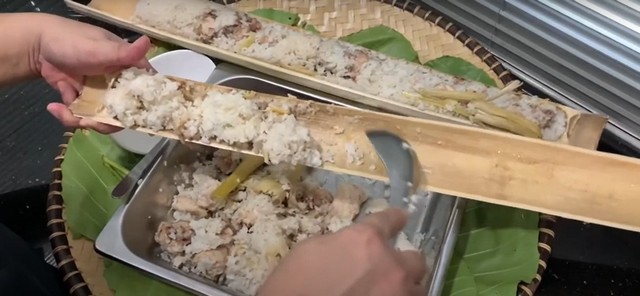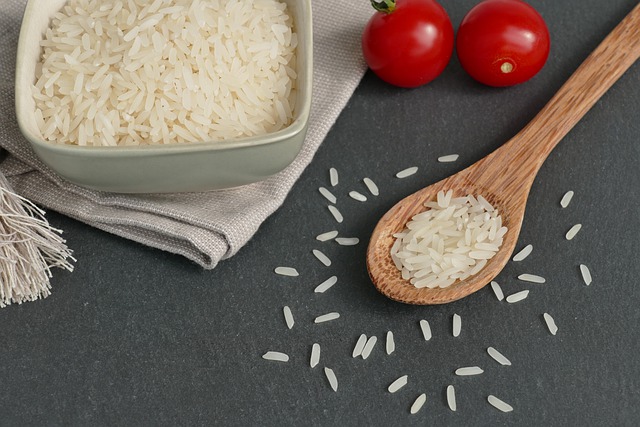Like many Asian countries, rice is a staple in Sarawak as it widely consumed by all the communities here.
Paddy planting is considered as a way of life for the different communities of Sarawak such as Bidayuh, Bisaya, Chinese, Iban, Malay and Orang Ulu.
Rice can be prepared in various ways as paddy planting is the main agriculture crop here.
In typical Sarawak style rice-based dishes are often prepared in large group of people that required teamwork and communal effort.
For this write-up on traditional food and dishes, Rakan Sarawak is focusing on rice-based festive food in the Bidayuh (tiboduk, asam siok, pangkang, tilamuak) and Iban community (asi ruas, penganan, kasam).
From the list below, how many of these traditional dishes have you tried?
Tiboduk
Tiboduk is a traditional Bidayuh dish which is actually sticky rice cooked in bamboo. Typically, to prepare this dish, glutinous rice will be used. At first, the rice is pounded into fine powder before it is mixed with melted palm sugar. Then, the mixture is wrapped with banana leaves before inserted into bamboo and cooked on fire wood for about an hour.

The tiboduk dish has a sticky consistency and a sweet fragrant smell of palm sugar.
Asam siok
Asam siok is a traditional Bidayuh chicken and rice dish cooked in bamboo.

Typically, asam siok is often compared to an Iban dish, ‘manok pansoh’ (chicken cooked in bamboo) due to its similar appearance and approach of cooking. However, unlike manok pansuh, the ingredients used to make asam siok is different as one of the ingredients for this Bidayuh version of a dish includes rice.
To prepare this dish, the chicken is first marinated with salt, ginger and lemongrass which has been sliced into smaller pieces. The chicken and rice are then mixed together before being stuffed into a bamboo until it is about three quarter full. The top of the bamboo is then stuff with tapioca leaves. The bamboo is then left to cook under open fire.
And unlike manoh pansuh where the content is poured out of the bamboo, the bamboo for asam siok is peeled off to reveal stuff rice and chicken.
Pangkang
Pangkang is a glutinous rice dish that is similar to pulut (a Malay rice dish), but the difference between pangkang and pulut is that the former is not wrapped in leaves. To prepare pangkang, the rice is stuff into a bamboo and left to cook in open fire. Once cooked, the bamboo is peeled to reveal the rice. Like any glutinous rice dish, pangkang is typically eaten accompanied with side dishes such as meat, fish and vegetable. As pangkang is cooked in bamboo, it is easy to carry around especially if you are going to the jungle where you will not worry about spilling out the content or disposing the bamboo as it is organic.
Tilamuak
One of Bidayuh’s popular rice-based dish is tilamuak. In some part of the Bidayuh community, it is also known as tramuak.

Tilamuak is basically rice steamed in pitcher plant. To prepare tilamuak, the glutinous rice is mixed with coconut milk and steamed for about an hour for it to fully cooked. While the dish is savoury enough without any extra ingredients, some prefer to add meat such as minced pork or chicken to their tilamuak. Others may prefer to add peanuts instead. Typically, tilamuak is served during special occasion such as Gawai, weddings or even during huge family gatherings.
While this rice dish is popular among consumer and is a highly sought-after delicacy, it has become a concern among conservationists and nature lovers because the usage of pitcher plants may lead to the extinction of the species.
It is also reported that apart from being exposed to threats caused by the practice of cooking rice using pitcher plant, this species is also facing danger of extinction from global warming.
Asi ruas
Asi ruas literally translated as rice in bamboo in Iban language. Asi ruas is similar to lemang (Malay’s glutinous rice) but unlike lemang, it does not use coconut milk. To make asi ruas, glutinous rice is used. The rice is first soak in water overnight. It is then inserted into a bamboo along with water until it is three quarter full. After the rice is cooked, the bamboo is cut into smaller pieces. The outer layer is peeled off to reveal fluffy and sticky glutinous rice. Typically, asi ruas is served during important occasions such as Gawai, weddings, and funerals. Like normal rice, it is usually enjoyed with side dishes such as pork and vegetables.

Apart from celebrations, asi ruas is also an important component in the miring ceremony. To conduct a miring ceremony, a set of offerings is prepared and it usually contains specified off numbers (1, 3, 5 or 7) traditional items such as nipah leaves cigarettes, sireh, penganan iri (sweet glutinous rice cake), penganan jala (crispy rice cake) poprice, hard boiled eggs, tuak and asi ruas.
Penganan
When visiting to any Iban longhouse during Gawai, the celebration will not be complete without the presence of kuih penganan or penganan cakes.

This traditional Iban delicacy is made out of rice flour, wheat flour, palm sugar and enough water to mix the ingredients into a batter. Before Gawai, it is not an uncommon sight to see a group of women preparing the penganan batter and frying them together.
Generally, penganan can be found in three forms, penganan ili (soft round cake with bulging curve), penganan chuan (crispy cake with flower like pattern shaped from stainless steel mould) and penganan jala (net like crispy cake).
Apart from serving them to gusts, penganan ili is also an important element of the Iban’s miring ceremony.
Kasam
Kasam refers to a preservation method of in which meat or vegetable is preserved using salt. While kasam is a common method using minimal ingredients, it is a difficult skill to pick up as it requires a lot of training to get the right flavour.
Typically, the most common meat used for kasam are either pork or fish and the ingredients needed for kasam are rock salt and rice that has been pounded and shallow fried in a pan. To prepare, the meat is thoroughly mixed with the salt and rice and kept in a jar for weeks and even months before it can be ready for consumption. This may be a tricky step as the ratio of meat and salt may differ for each individual preparing it.
Sometimes, kepayang leaves can be added as flavour enhancer. For kasam, rice is an important ingredient as it provides as the source of food for the fermentation process to prepare kasam.
It is also worth mentioning that apart from Iban, other ethnic communities such as the Bidayuh also uses rice or paddy to ferment pork and fish and has their own version of kasam dishes.






